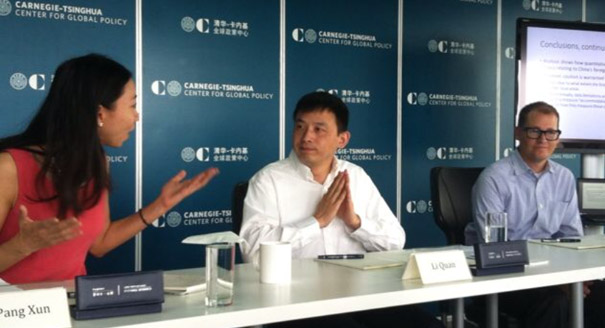Registration
You will receive an email confirming your registration.
As a critical part of a rapidly developing region that is a hub for global trade and business, it has become crucial for China to build more sustainable and positive relations with its neighbors amidst a multitude of challenges and tensions. The revival of a “New Silk Road” stretching from central to southeast necessitates cordial relations even more. After the 2013 APEC Summit, President Xi urged connectivity in the Asia Pacific. Now, eight months after the summit how much, if any, progress has China made toward these objectives?
Carnegie–Tsinghua’s Pang Xun hosted a panel discussion featuring professor Li Quan, a professor at Texas A&M University, and professor Scott Kastner of the University of Maryland to share the results of data and research they have collected over many years on the interactions between China and its neighbors.
Discussion Highlights
- The Rise of China: The research for this report suggests that the likelihood of a militarized dispute is much higher during the first year after a conflict, the participants said. However, the probability of militarized disputes decreases with the number of years of peace. In addition, the scholars noted that China’s rise is mostly an economic phenomenon, and that trade has a pacifying effect on relations between China and its neighbors. Given this, the long term trend in bilateral trade growth is encouraging, they concluded.
- Power Parity and the Risk of Conflict: The participants explained that as China and its neighbors approach power parity, there is an increased risk for conflict. This is primarily the case when there have been conflicts and tensions between the regional powers in the recent past, they added. However, power shifts toward parity have little effect after a bilateral relationship has been at peace for a long period. Given this, scholars noted that there is minimal risk of conflict between China and the majority of its neighbors, but the China-Japan dynamic requires close watch in the coming years.
- China’s Economic Ties and Influence: China’s burgeoning economic ties with its neighbors can be viewed as a threat by other countries due to hollowing out effects, import competing industries, as well as the influence that China has to affect policies in those countries, participants said. Media reports throughout the region tend to focus on cases where economic ties with China lead to apparent changes in behavior, so if no change in behavior occurs, it is likely to go unreported. The scholars found that China’s economic ties in the region generally only help them to influence policy in economic arenas, but that further research is necessary to study the political influence of economic ties.
- Quantitative Studies and Understanding China’s Foreign Policy: Panelists argued that quantitative studies can shed light on important issues related to China’s foreign policy. However, they cautioned against using their research to generalize about other thematic or geographical areas in China’s foreign policy as it is not clear to what extent the findings presented would be applicable across the board. More broadly, data limitations are a clear issue. For instance, they said, it can be difficult to measure “accommodation.” The panelists emphasized the need to think carefully about how researchers measure these sorts of concepts in a cross-national framework.
